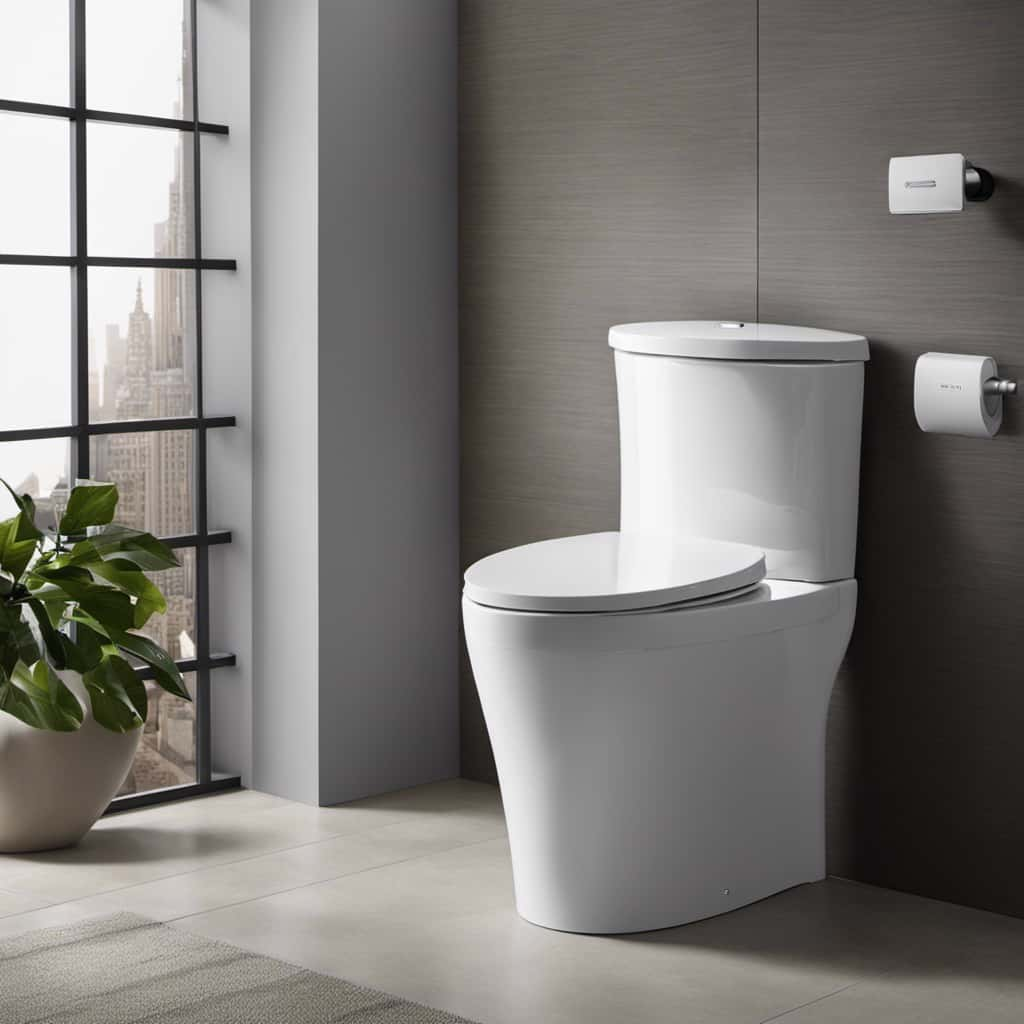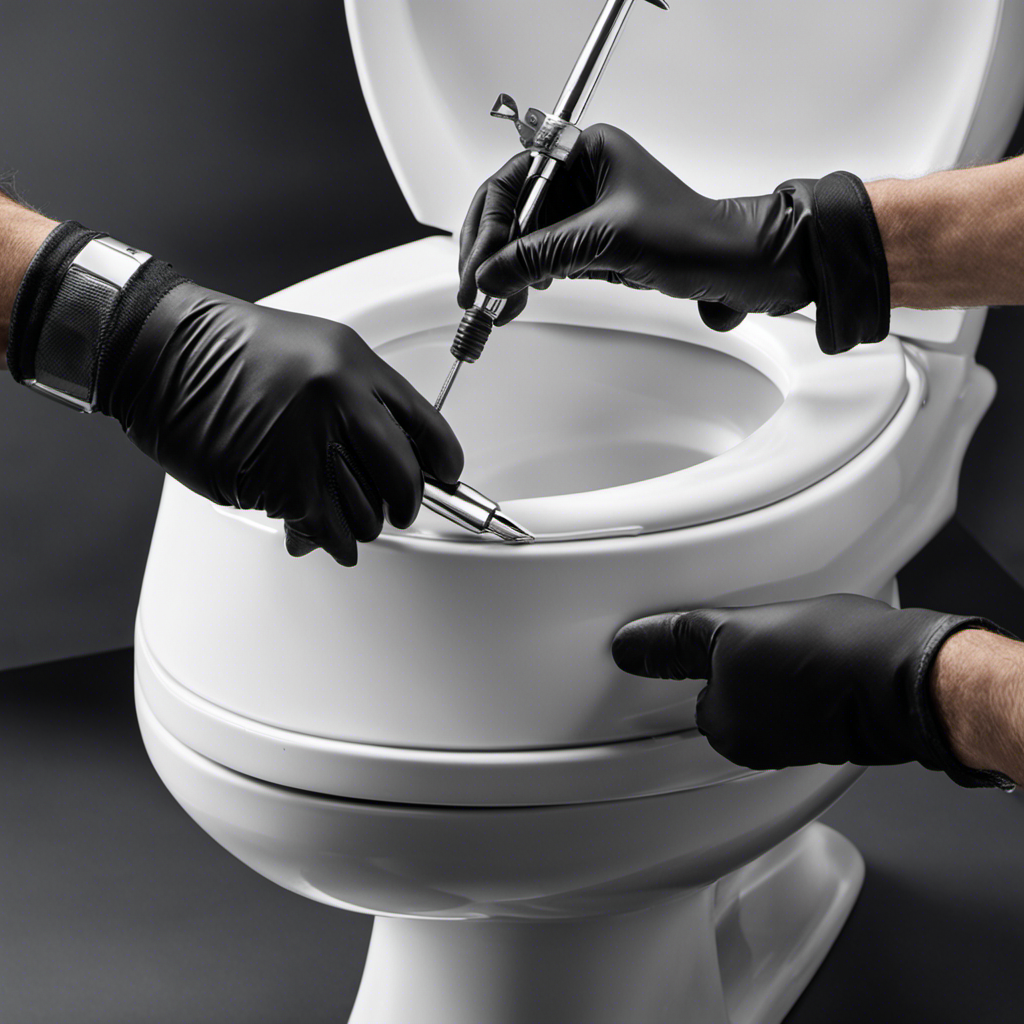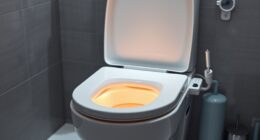As they say, ‘Sometimes the smallest things can make the biggest noise.’ And in the case of a whistling toilet when it’s filling, that noise can be quite frustrating.
But fear not, because in this article, I’ll share with you the possible causes of this annoying issue, how to diagnose it, and step-by-step instructions on how to fix it.
Plus, I’ll give you some tips on preventing it from happening again.
So let’s dive in and silence that whistling once and for all!
Key Takeaways
- Possible causes of toilet whistling when filling include blockages in the water supply line, restricted water flow, partially closed shut-off valve, and clogs or obstructions in the supply line.
- To diagnose a whistling toilet, check the water supply valve, turn off the water supply valve and flush the tank, slowly open the valve to fill the tank, and inspect the valve for damage or debris.
- Steps to fix a whistling toilet include checking if the water supply valve is fully open, cleaning or replacing the fill valve, adjusting the water level in the ballcock assembly, ensuring proper functioning of the float and float arm, and considering replacing the fill valve or consulting a professional.
- To prevent toilet whistling in the future, regularly maintain and clean the fill valve and ballcock assembly, understand that toilet whistling can indicate underlying problems, address high water pressure issues, prevent debris buildup, and ensure proper ventilation.
Possible Causes of Whistling Toilet When Filling
One possible cause of a whistling toilet when filling is a blockage in the water supply line. This is a common toilet problem that can be easily resolved with some troubleshooting.
The whistling sound occurs when the water flow is restricted due to a blockage in the supply line, causing it to create a high-pitched sound as it tries to pass through.
To diagnose this issue, you can start by checking the shut-off valve to ensure it is fully open. If the valve is open and the whistling persists, you may need to inspect the supply line for any clogs or obstructions.
How to Diagnose a Whistling Toilet
To diagnose a whistling toilet, you can start by checking the water supply valve. A whistling sound during the filling process is one of the common toilet problems that homeowners often encounter. Troubleshooting toilet issues requires a systematic approach.
Begin by turning off the water supply valve behind the toilet and flushing to empty the tank. Next, slowly open the valve to allow the water to fill the tank. If the whistling sound persists, it could indicate a problem with the valve or the fill valve assembly. Inspect the valve for any signs of damage or debris that may be causing the whistling. If necessary, clean or replace the valve to resolve the issue.
Transitioning into the subsequent section about steps to fix a whistling toilet, let’s explore the various solutions available.
Steps to Fix a Whistling Toilet
Check if the water supply valve is fully open and not partially closed, as this can cause a whistling sound in your toilet. If the valve is fully open and the whistling persists, there are a few steps you can take to fix the issue.
First, check the fill valve and ensure it is free from any debris or mineral buildup. If necessary, clean or replace the fill valve to restore proper water flow.
Next, inspect the ballcock assembly and adjust the water level if it is too high. Additionally, make sure the float and float arm are functioning properly.
If these steps do not resolve the problem, it may be necessary to replace the fill valve or consult a professional for further toilet repair.
Preventing Toilet Whistling in the Future
If the water supply valve is fully open and the whistling persists, you can prevent future whistling by regularly maintaining and cleaning the fill valve and ballcock assembly. Many people have common misconceptions about toilet whistling, believing it to be a minor issue that doesn’t require attention. However, this is not the case. Toilet whistling can be a sign of underlying problems, such as high water pressure, which can lead to damage and leaks if left unaddressed. The impact of water pressure on toilet whistling is significant. Excessively high water pressure can cause the fill valve to vibrate, resulting in the whistling sound. By regularly maintaining and cleaning the fill valve and ballcock assembly, you can prevent debris buildup and ensure proper functioning, reducing the chances of toilet whistling in the future.
| Common Misconceptions | Impact of Water Pressure |
|---|---|
| Minor issue | Underlying problems |
| No attention needed | Damage and leaks |
| Vibrating fill valve |
When to Call a Professional for a Whistling Toilet Issue
When the whistling sound persists despite regular maintenance and cleaning, it may be time to call a professional for assistance with your toilet issue. While there are many common toilet problems that can be fixed with DIY toilet repairs, a persistent whistling noise during the filling process may indicate a more complex issue.
Here are a few reasons why calling a professional may be necessary:
- Water pressure: A professional can determine if the whistling is caused by high water pressure and install a pressure-reducing valve if needed.
- Faulty fill valve: A professional can inspect and replace a faulty fill valve, which can cause whistling sounds.
- Ventilation issues: A professional can assess and fix any ventilation problems that may be causing the whistling noise.
- Plumbing system assessment: A professional can perform a comprehensive assessment of your plumbing system to identify any underlying issues contributing to the whistling sound.
Calling a professional ensures that the root cause of the whistling noise is properly diagnosed and repaired, providing you with a long-term solution to your toilet issue.
Frequently Asked Questions
Can a Whistling Toilet Be a Sign of a More Serious Plumbing Problem?
A whistling toilet can indicate a serious plumbing issue. Ignoring it can lead to water leaks, damage to the toilet, or even bigger plumbing problems. Other common causes of toilet noises should be checked as well.
How Long Does It Typically Take to Diagnose a Whistling Toilet Issue?
Typically, diagnosing a whistling toilet issue can take anywhere from a few minutes to a couple of hours, depending on the complexity of the problem. Common causes include faulty fill valve or water pressure irregularities.
Are There Any Temporary Fixes for a Whistling Toilet Until a Professional Can Be Called?
I know a few temporary fixes for a whistling toilet. It’s important to address the common causes of toilet whistling, such as a faulty fill valve or water pressure issues, before calling a professional.
Can Hard Water Contribute to a Toilet Whistling When Filling?
Yes, hard water can contribute to a toilet whistling when filling. The mineral deposits from hard water can build up in the toilet’s fill valve, causing it to vibrate and create a whistling sound. Troubleshooting toilet noises is essential in addressing this issue.
Are There Any Home Remedies or DIY Solutions to Prevent a Toilet From Whistling in the Future?
To prevent a toilet from whistling, try adjusting the water supply valve or replacing the fill valve. If DIY solutions don’t work, it’s best to consult a professional plumber for a more precise and technical fix.
Conclusion
So there I was, standing in my bathroom, perplexed by the strange whistle coming from my toilet. After some investigation, I discovered that a whistling toilet can be caused by several factors, from a faulty fill valve to a worn-out flapper.
Armed with my newfound knowledge, I was able to diagnose and fix the issue myself, saving me time and money. By following a few simple steps, I successfully silenced the annoying whistle and prevented it from happening again in the future.
However, if you find yourself facing a stubborn whistling toilet, don’t hesitate to call a professional for assistance.










